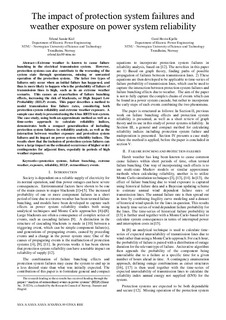The impact of protection system failures and weather exposure on power system reliability
Chapter
Accepted version

Åpne
Permanent lenke
http://hdl.handle.net/11250/2640086Utgivelsesdato
2019Metadata
Vis full innførselSamlinger
- Institutt for elkraftteknikk [2468]
- Publikasjoner fra CRIStin - NTNU [38127]
Originalversjon
10.1109/EEEIC.2019.8783388Sammendrag
Extreme weather is known to cause failure bunching in the electrical transmission system. However, protection systems can also contribute to the worsening of the system state through spontaneous, missing or unwanted operation of the protection system. The latter two types of failures only occur when an initial failure has happened, and thus is more likely to happen when the probability of failure of transmission lines is high, such as in an extreme weather scenario. This causes an exacerbation of failure bunching effects, increasing the risk of blackouts, or High Impact Low Probability (HILP) events. This paper describes a method to model transmission line failure rates, considering both protection system reliability and extreme weather exposure. A sample case study is presented using the 6 bus RBTS test-system. The case study, using both an approximate method as well as a time-series approach to calculate reliability indices, demonstrates both a compact generalization of including protection system failures in reliability analysis, as well as the interaction between weather exposure and protection system failures and its impact on power system reliability indices. The results show that the inclusion of protection system failures can have a large impact on the estimated occurrence of higher order contingencies for adjacent lines, especially in periods of high weather exposure.